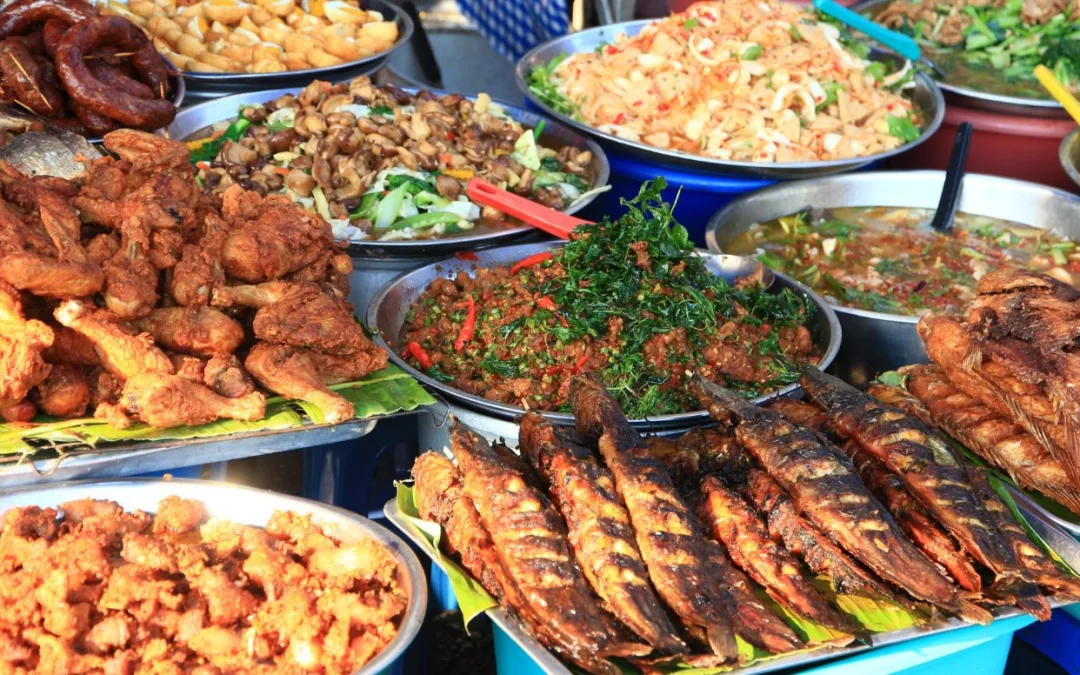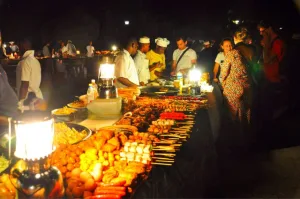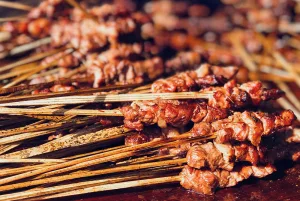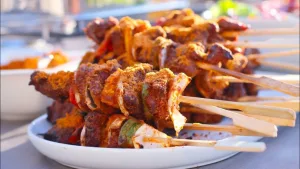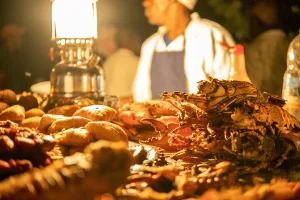Africa is a continent bursting with rich cultures, vibrant traditions, and, of course, mouth watering street food. From the bustling streets of Lagos to the markets in Nairobi, the flavors of Africa are diverse and unforgettable. African Street Food Guide is your passport to explore the delicious and often overlooked world of street food, where every bite tells a story. Whether you’re craving spicy, savory, or sweet treats, Africa’s street food scene offers something for every palate.
African street food offers a vibrant mix of flavors, influenced by the continent’s diverse cultures. In West Africa, you can try suya, spicy skewered meat, and puff-puff, sweet dough balls. East Africa features dishes like nyama choma (grilled meat) and mandazi, fried dough often served with tea. North Africa’s street food includes falafel and shawarma, with bold spices and fresh herbs.
In Southern Africa, biltong (dried cured meat) and bunny chow (a curry-filled bread loaf) are popular. Street vendors across Africa often sell fresh fruit, coconut drinks, and fried plantains. Whether sweet or savory, each region’s food offers an authentic taste of its local traditions and ingredients.
Importance of street food in African cultures.
Street food plays a vital role in African cultures, offering more than just a meal; it is a symbol of tradition, community, and economic empowerment. Here is explanation of its importance:
- Cultural Heritage and Tradition
Street food reflects the culinary traditions and diversity of African cultures. Local dishes, passed down through generations, are often sold on the streets, maintaining traditional cooking techniques and recipes. - Affordability
Street food is typically inexpensive, making it accessible to a wide range of people, from the working class to students. It provides a cost-effective way for individuals to enjoy a meal without breaking the bank. - Convenience
Street food is quick and easy, allowing people to grab a bite while going about their daily activities. It supports busy lifestyles, providing an immediate and satisfying solution for hunger. - Social Interaction
Street food vendors are central to community interaction. People gather around food stalls, engaging in conversation and building social ties. It fosters a sense of belonging and camaraderie among locals. - Economic Empowerment
Many street food vendors are small business owners, often operating with low overhead costs. This creates opportunities for entrepreneurship and economic independence, especially in informal economies. - Variety and Innovation
African street food is diverse, offering a wide range of flavors, ingredients, and cooking methods. Vendors often innovate, combining traditional foods with new ingredients or presenting familiar dishes in creative ways. - Local Ingredients
Street food vendors often use locally sourced ingredients, which supports local farmers and markets. This helps maintain the agricultural economy and promotes sustainable food practices. - Tourist Attraction
Street food is an important part of Africa’s tourism industry. Visitors seek authentic, flavorful experiences, and local street food provides an opportunity to taste the real essence of African cuisine. - Festivals and Celebrations
During cultural and religious festivals, street food becomes a central element of the celebration. Special dishes are often prepared for these occasions, adding to the festivity and cultural expression. - Health and Nutrition
While some street food may be high in calories, many vendors offer healthy options such as fruits, grilled vegetables, and whole grains, contributing to a balanced diet.
Street food in Africa is more than just a culinary trend; it is a cornerstone of cultural identity, social life, and economic activity. It nourishes both the body and the community, offering a rich, authentic experience that connects people to their heritage, each other, and the wider world.
The Best African Street Foods You Must Try
African street food offers an incredible variety of flavors, textures, and aromas that showcase the continent’s culinary diversity. Below are the list of some of the best African street foods you must try:
- Jollof Rice (West Africa)
A beloved one-pot dish made with rice, tomatoes, onions, and a mix of spices. Often served with grilled meats or fried plantains, it is a must-try staple in countries like Nigeria, Ghana, and Senegal. - Samosas (East Africa)
Popular in Kenya and Tanzania, these crispy, golden pastries are filled with spiced meat, vegetables, or lentils. They’re perfect for a quick snack on the go. - Bunny Chow (South Africa)
A hollowed-out loaf of bread filled with spicy curry. This hearty street food originated in Durban and is loved for its bold flavors and satisfying portions. - Chapati (East Africa)
A flatbread that is a staple in Kenya and Uganda. It is often served with stews, beans, or fried eggs for a simple yet delicious meal. - Suya (Nigeria)
Grilled skewers of spiced meat, typically beef or chicken, coated with a peanut-based spice mix. Suya is a flavorful and smoky treat sold by street vendors across Nigeria. - Puff-Puff (West Africa)
Sweet, fried dough balls, similar to donuts. They are soft, fluffy, and a popular snack or dessert in countries like Nigeria, Ghana, and Cameroon. - Bofrot/Makara (West and East Africa)
These deep-fried dough balls are slightly sweet and chewy, making them a perfect snack or breakfast item in Ghana and Tanzania. - Nyama Choma (Kenya)
Grilled meat, often goat or beef, seasoned with minimal spices to let the natural flavors shine. It’s a social food commonly enjoyed with friends and family. - Akara (West Africa)
Fried bean cakes made from black-eyed peas and spices. They are crispy on the outside, soft on the inside, and are usually eaten as breakfast or a snack. - Kelewele (Ghana)
Spicy fried plantains seasoned with ginger, garlic, and pepper. It’s a flavorful and slightly sweet dish that’s loved by locals and visitors alike. - Boerewors Rolls (South Africa)
A South African version of a hotdog, featuring grilled boerewors (sausage) served in a roll with chutney, onions, or mustard. - Mishkaki (Tanzania)
Skewered and grilled pieces of meat, often marinated in spices like garlic, ginger, and chili. A popular evening snack sold by street vendors. - Fataya (Senegal)
Deep-fried pastries filled with meat, fish, or vegetables. These savory treats are a street food favorite in Senegal and other West African countries. - Ugandan Rolex (Uganda)
A rolled-up chapati filled with eggs, tomatoes, onions, and cabbage. This quick and delicious street food is a favorite among locals and travelers. - Moi Moi (Nigeria)
A steamed bean pudding made with ground beans, spices, and optional additions like fish or boiled eggs. It’s a savory and protein-rich snack. - Koki Corn (Cameroon)
A dish made from fresh corn and spices, steamed in banana leaves. It’s a unique and flavorful street food option. - Zanzibar Pizza (Tanzania)
A street food delicacy where a thin dough is filled with meats, vegetables, eggs, and cheese, then fried until golden and crispy. - Roasted Corn (Across Africa)
A simple yet delicious street food where corn is grilled over an open flame. It’s often enjoyed plain or with a sprinkling of salt or chili. - Fried Fish (Senegal)
Freshly caught fish, fried and served with tangy sauces and bread or rice. A street food staple in coastal regions. - Mbisi ya Nyama (DR Congo)
A skewered and grilled meat dish that’s marinated in a rich blend of local spices.
African street food is a testament to the continent’s rich culinary traditions and creativity. From spicy skewers to sweet fried treats, each dish offers a unique taste of the region it hails from. Exploring these foods is not just a culinary adventure but a way to connect with the vibrant cultures of Africa.
Where to Find the Best African Street Food
African street food is best experienced in bustling markets, roadside stalls, and vibrant food districts across the continent. Here’s a guide to where you can find some of the best African street food:
West Africa
- Lagos, Nigeria
- Street food hubs like Balogun Market and Lekki Night Market offer delicious options such as Suya, Puff-Puff, and Akara.
- “Mama put” joints are also great for authentic Jollof Rice and Moi Moi.
- Accra, Ghana
- Makola Market and Osu’s Oxford Street are famous for Kelewele, grilled tilapia, and Waakye.
- Beachside stalls often sell fresh roasted corn and coconut water.
- Dakar, Senegal
- Explore Sandaga Market for Fataya, grilled fish, and Yassa.
- The Corniche area near the ocean is great for fresh seafood.
East Africa
- Kampala, Uganda
- Nakasero Market and Owino Market are perfect spots to grab a Rolex or freshly grilled meat skewers.
- Roadside vendors sell boiled and roasted bananas known as Gonja.
- Dar es Salaam, Tanzania
- Visit Kariakoo Market or the Fish Market for Mishkaki, Zanzibar Pizza, and Mandazi.
- Temeke area is known for its vibrant food stalls and Swahili delicacies.
- Nairobi, Kenya
- Kenyatta Market and Gikomba Market are hotspots for Nyama Choma, Samosas, and Mutura (Kenyan sausage).
- Street-side vendors often sell fresh sugarcane juice and Chapati.
North Africa
- Marrakech, Morocco
- The iconic Jemaa el-Fnaa square is a paradise for Moroccan street food, including Msemen, harira soup, and grilled meats.
- Street carts offer a variety of sweets like chebakia and dates.
- Cairo, Egypt
- Explore Khan el-Khalili and downtown areas for koshari, falafel, and grilled kofta.
- Vendors along the Nile sell freshly baked flatbreads and stuffed pigeons.
Southern Africa
- Durban, South Africa
- Try Bunny Chow and Boerewors Rolls at Victoria Street Market or Florida Road.
- Beachfront stalls offer fresh seafood and samosas.
- Lusaka, Zambia
- Soweto Market is known for grilled meats, fried cassava, and local drinks like Maheu.
- Harare, Zimbabwe
- Visit Mbare Musika Market for Sadza, roasted peanuts, and Mopane worms.
Central Africa
- Kinshasa, DR Congo
- Enjoy Mbisi ya Nyama and fried plantains at markets like Gambela or Matete.
- Street vendors also offer grilled fish with spicy sauces.
- Douala, Cameroon
- Explore Marché des Fleurs for Koki Corn, Ndolé (bitterleaf stew), and grilled fish.
- Street stalls sell Makara and spicy boiled peanuts.
Island Nations
- Stone Town, Zanzibar (Tanzania)
- The Forodhani Night Market is a must-visit for Zanzibar Pizza, Urojo (soup), and fresh seafood.
- Local vendors also offer coconut bread and spiced coffee.
- Antananarivo, Madagascar
- Explore Analakely Market for local snacks like Mofo Gasy (Malagasy pancakes) and Koba (rice cake).
African street food can be found in vibrant markets, lively streets, and coastal areas where vendors offer an authentic taste of their regions. Whether you’re in a bustling city or a serene island, the street food culture provides an unforgettable culinary journey filled with bold flavors and rich traditions.
Street Food Etiquette and Tips
Enjoying street food in Africa is a delightful experience, but understanding the etiquette and following some helpful tips can enhance your culinary adventure. Here’s a detailed guide:
Street Food Etiquette
- Respect Local Customs
- Observe how locals interact with vendors and follow their lead.
- If there’s a queue, wait your turn patiently.
- Ask Before Taking Photos
- Vendors and locals may find it intrusive if you start snapping photos without permission. Always ask politely before taking pictures of the food or the setup.
- Carry Small Cash
- Street food is typically inexpensive, and vendors often don’t have change for large bills. Having small denominations will make transactions smoother.
- Cleanliness Matters
- Observe the vendor’s hygiene practices. Choose stalls where the food is handled with care, and utensils are kept clean.
- Be Polite
- Greet the vendor with a smile or a simple “hello” in the local language. Showing appreciation for their food and effort goes a long way.
- Don’t Waste Food
- Order only what you can eat. Wasting food is considered disrespectful in many cultures.
- Share Communal Spaces
- If seating is available and shared, don’t linger after finishing your meal to make room for others.
- Use Your Hands Wisely
- In some African cultures, eating with your right hand is customary. If utensils are provided, use them as per the vendor’s instructions.
Street Food Tips
- Research Popular Dishes
- Familiarize yourself with the local street food specialties before venturing out. This ensures you don’t miss out on must-try dishes.
- Go Where Locals Go
- Busy stalls with long lines are often a sign of good quality and fresh food.
- Watch the Cooking Process
- Choose vendors who prepare the food fresh in front of you. This ensures both taste and hygiene.
- Be Cautious with Water and Ice
- Stick to bottled water or drinks in sealed containers to avoid stomach issues. Avoid ice if you’re unsure of the water source.
- Taste the Spices Gradually
- African street food can be spicy. If you’re not accustomed to heat, ask for less spice or try a small portion first.
- Carry Hand Sanitizer or Wet Wipes
- Street food is often eaten with your hands, so having sanitizer or wipes handy is useful.
- Avoid Peak Sun Hours
- Street food is often best enjoyed in the cooler parts of the day, such as early morning or late afternoon. Heat can affect the freshness of some items.
- Learn Basic Phrases
- Knowing simple words like “thank you” or “how much?” in the local language can make the experience more enjoyable and respectful.
- Sample Small Portions
- If you want to try a variety of foods, buy smaller portions to leave room for more tastings.
- Be Adventurous but Smart
- Don’t hesitate to try something new, but trust your instincts. If something doesn’t look or smell right, it’s okay to skip it.
By following proper etiquette and practical tips, you can fully enjoy the vibrant and diverse street food culture across Africa. Respecting local customs, being mindful of hygiene, and embracing new flavors will make your street food adventure both memorable and rewarding.
African Street Food and Its Global Influence
African street food is not only a cornerstone of local culture but has also had a profound influence on global culinary trends. Its bold flavors, diverse ingredients, and rich traditions have crossed borders, inspiring food scenes worldwide. Here’s an exploration of African street food and its global impact:
Key Characteristics of African Street Food
- Diverse Flavors
- African street food showcases a fusion of sweet, savory, spicy, and tangy flavors, often derived from indigenous spices like berbere, suya spice, and peri-peri.
- Simple and Fresh Ingredients
- Local produce, fresh meats, and grains like millet, cassava, and maize form the backbone of many dishes, offering an authentic and natural taste.
- Community-Centric Cooking
- Many dishes are prepared in communal settings, emphasizing shared meals and social interaction, a value that resonates with global food culture.
Global Influence of African Street Food
- Popularization of Ingredients
- Ingredients like plantains, cassava, and yams have gained popularity in international cuisines, thanks to African street food. Fried plantains (Kelewele) are now common in Caribbean and Latin American dishes.
- Fusion with Other Cuisines
- African street food has inspired fusion dishes in global culinary scenes. For instance:
- Peri-peri chicken, originating from Southern Africa, has become a worldwide sensation through chains like Nando’s.
- Moroccan flatbreads and tagines influence Mediterranean and Middle Eastern cuisines.
- African street food has inspired fusion dishes in global culinary scenes. For instance:
- Introduction of Spices and Sauces
- African spice blends, such as suya spice (Nigeria) and harissa (North Africa), are increasingly featured in global recipes and gourmet restaurants.
- Street Food Culture
- African street food’s vibrant market setups have inspired food trucks and stalls globally, particularly in urban food festivals and night markets.
- Recognition in Culinary Media
- African street food is now a staple in food documentaries, cookbooks, and television shows, bringing dishes like Bunny Chow, Jollof Rice, and Ugandan Rolex into the global spotlight.
Examples of Global African Street Food Adaptations
- Jollof Rice Variations
- The West African dish has inspired interpretations in international cuisine, blending it with Asian fried rice techniques or pairing it with Western-style grilled meats.
- Chapati Rolls (Rolex)
- This East African street food has become popular in international markets as a customizable wrap, similar to burritos or shawarmas.
- Samosas
- Originating from Indian influence in East Africa, samosas have become a global snack with African-inspired fillings like spiced beef and lentils.
- Roasted Corn and Peanuts
- Simple African street snacks like roasted corn and peanuts are replicated at global food fairs and farmers’ markets.
- Mandazi (Fried Dough)
- This East African sweet treat is now found in coffee shops and bakeries worldwide, often marketed as an exotic doughnut.
Driving Factors Behind the Global Spread
- Migration and Diaspora
- African communities around the world have introduced their traditional street foods to new audiences.
- Social Media and Food Blogging
- Platforms like Instagram and YouTube have highlighted the vibrant presentation and unique preparation of African street food, sparking global interest.
- Gourmet Trends
- Chefs and food enthusiasts have elevated traditional street food into gourmet experiences, making it accessible to upscale markets.
- Food Festivals and Pop-Ups
- African food festivals and street food pop-ups in cities like London, New York, and Dubai have made these dishes more mainstream.
African street food’s global influence is a testament to its universal appeal. Its vibrant flavors, rich cultural history, and innovative preparations have transcended borders, reshaping culinary landscapes worldwide. As African street food continues to gain recognition, it brings people closer to the continent’s rich traditions and diverse cultures.
Street Food Pairings: Drinks and Sides
Pairing street food with the right drinks and sides enhances the overall experience, bringing out the unique flavors and textures of the main dish. Here’s a guide to the best street food pairings for African dishes:
West African Street Food Pairings
- Jollof Rice
- Drinks: Zobo (hibiscus drink), palm wine, or a chilled ginger beer.
- Sides: Fried plantains (Kelewele) or steamed Moi Moi (bean pudding).
- Suya (Spiced Meat Skewers)
- Drinks: Malt drinks, spicy ginger juice, or a cold lager beer.
- Sides: Sliced onions, tomatoes, and pepper sauce.
- Akara (Fried Bean Cakes)
- Drinks: Akamu (fermented pap) or a sweetened herbal tea.
- Sides: Bread rolls or fried yam slices.
- Kelewele (Spiced Plantains)
- Drinks: Tamarind juice or sobolo (local hibiscus tea).
- Sides: Groundnuts (peanuts) or grilled tilapia.
- Puff-Puff (Sweet Fried Dough)
- Drinks: Bissap (hibiscus tea) or hot spiced tea.
- Sides: A sprinkle of powdered sugar or dipping chocolate.
East African Street Food Pairings
- Rolex (Chapati and Egg Roll-Up)
- Drinks: Passion fruit juice or chai tea.
- Sides: Grilled vegetables or a fresh kachumbari salad (tomato and onion salad).
- Samosas
- Drinks: Sweetened black tea or mango lassi.
- Sides: Tamarind sauce or chili dipping sauce.
- Nyama Choma (Grilled Meat)
- Drinks: Tusker beer, sugarcane juice, or a chilled soda.
- Sides: Ugali (maize porridge) or sukuma wiki (collard greens).
- Mandazi (Fried Sweet Bread)
- Drinks: Spiced tea or coconut milk.
- Sides: Fresh tropical fruits like mango or pineapple.
- Mishkaki (Grilled Meat Skewers)
- Drinks: Coconut water or tamarind juice.
- Sides: Chapati or rice pilaf.
North African Street Food Pairings
- Msemen (Flatbread)
- Drinks: Mint tea or strong black coffee.
- Sides: Honey or olive oil for dipping.
- Falafel
- Drinks: Fresh lemonade or pomegranate juice.
- Sides: Tahini sauce and pickled vegetables.
- Harira Soup
- Drinks: Mint tea or rosewater lemonade.
- Sides: Chebakia (sesame cookies) or freshly baked bread.
- Grilled Kofta (Meat Skewers)
- Drinks: Hibiscus tea or a cold yogurt drink.
- Sides: Couscous or a fresh cucumber salad.
Southern African Street Food Pairings
- Bunny Chow
- Drinks: Mango lassi or ginger beer.
- Sides: Sambals (spicy relish) or pickled vegetables.
- Boerewors Roll
- Drinks: Rooibos iced tea or a craft beer.
- Sides: Potato salad or fried onions.
- Fat Cakes (Magwinya)
- Drinks: Sweetened coffee or hot chocolate.
- Sides: Polony slices or jam for spreading.
- Grilled Maize
- Drinks: Fresh lime water or a light lager beer.
- Sides: Chili butter or grated cheese.
Island Nations and Coastal Areas
- Zanzibar Pizza
- Drinks: Sugarcane juice or tamarind soda.
- Sides: Coconut chutney or fresh salad.
- Fried Fish
- Drinks: Coconut water or a citrus-based mocktail.
- Sides: Ugali or cassava chips.
Universal Pairings for African Street Food
- Drinks:
- Herbal teas (hibiscus, ginger, or mint).
- Fermented drinks like palm wine or sorghum beer.
- Freshly pressed juices from tropical fruits like mango, pineapple, and tamarind.
- Sides:
- Fresh salads with tomatoes, onions, and cucumbers.
- Simple starches like bread, rice, or boiled yams.
- Spicy relishes or dipping sauces for an extra kick.
Pairing the right drink or side dish with African street food elevates its flavors and makes the meal more satisfying. Whether it’s a hearty Jollof Rice with palm wine or a simple Puff-Puff with spiced tea, these combinations offer a deeper appreciation for the vibrant street food culture of Africa.
Conclusion
Exploring the African Street Food Guide unveils a vibrant tapestry of flavors, cultures, and traditions that showcase the heart and soul of the continent. From spicy suya in Nigeria to zesty bunny chow in South Africa, every bite tells a unique story. Dive in, savor the diversity, and let the streets of Africa food guide you to unforgettable culinary adventures.

